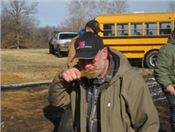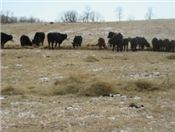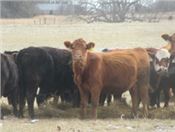|
Treated Hay Demonstration: "Show, Tell And Smell"

The smell test
Photo credits: University of Missouri Extension
Gets Dramatic Reaction From Humans And Cattle
MT. VERNON, MO.
A small, but interested audience visited the University of Missouri Southwest Research Center south of Mt. Vernon on a cold, late January day to learn about feeding anhydrous ammonia-treated fescue hay.
Attendees were shown the hay, told about the process and also smelled it according to Eldon Cole, field specialist in livestock with University of Missouri Extension.
The low-quality fescue hay was treated in early July with 2.5 percent anhydrous ammonia. The hay was stacked and covered with a six mil plastic with 109, 910-pound bales under it. The three stacks remained covered until one was opened Jan. 4 to begin feeding the Southwest Center’s fall-calving beef cow herd. The cost per bale was $10.61.
“The cows have been grazing stockpiled fescue pasture in addition to the hay. Grazing material is becoming scarce, and about 25 to 30 pounds of hay is fed per cow per day currently. The September-October calves also like the treated hay,” said Cole.
Tests taken in July showed a crude protein (CP) level of 9.4 percent; total digestible nutrients (TDN) 51.7 percent; neutral detergent fiber (NDF) 64.4 percent; relative feed value (RFV) 79. Tests on the same bales when the stack was opened showed CP 15.4 percent; TDN 51.8 percent; NDF 58.2 percent; RFV 87.
Part of the show, tell and smell activity was the unrolling of an untreated, two-year-old fescue bale followed in 5 to 8 minutes by the unrolling of a treated bale.
“The cows performed perfectly by running to the treated bale after stopping briefly to smell and take a few bites of the untreated hay. The calves did the same,” said Cole.
Another group of cows across the fence reacted the same way.
“When the two different bales were unrolled. Not one single cow or calf out of 115 head stayed to eat the untreated hay,” said Cole.
Several questions were raised about side effects from eating treated hay. Toxicity may occur if too high-quality hay is treated. Examples would be alfalfa, sorghum x sudan, small grain hays and low NDF, warm or cool season grass.
According to Cole, the toxin causing the problems is 4-methylimidazole. Symptoms are nervousness, circling, convulsions, running through fences and sometimes death.
The toxin can be transmitted through the milk and real young calves may die from it.
Other precautions to take are: limit anhydrous ammonia to four percent; do not treat hay that contains wet spots as the anhydrous moves towards moisture; weigh the hay so you are pretty close to the amount of anhydrous to add.
Staff at the Southwest Center only noticed a couple of cows that acted a little goofy the first few feedings.
“They might have eaten more than their share of some “wet spot” hay. Since the calves were older, no problems were noted with them,” said Cole.
Humans should take a few precautions too. Always be careful when opening the stack as the ammonia smell can be very strong and will open your sinuses.
“Use protective gear when needed and having someone with you adds to the safety factor,” said Cole.
If you would like to see the cows’ reaction to what they think of treated hay, Cole suggests checking with staff at the Southwest Research Center, Mt. Vernon for a personal visit.
“We are, after all, the Show-Me State,” said Cole. ∆

Treated hay

Cattle and treated hay
|
|